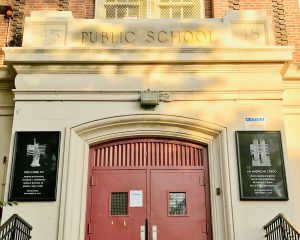By Abigail Murphy

I’ve always been told that New York City has the cleanest drinking water. I picture the vast reservoirs upstate in the Catskills and Croton Falls, complete with a ring of neatly trimmed evergreens surrounding a large pool of clear, sparkling water reflecting the blue sky above. The spring water flows effortlessly into our city, and this vision of pure water makes the city a little more bearable. It allows us to hold onto some sense of purity and simplicity amidst the chaos and, sometimes, the filth of New York City.
My perception began to change when a 2016 report from the Department of Education found that 83 percent of New York City schools had more than the acceptable amount of lead in their tap faucets. In fact, over 33,000 public school faucets were contaminated with 15 parts per billion (ppb) of lead, the level at which the state is required to take action.
Lead affects the nervous system of people exposed to it, harming the development of children and inhibiting their cognitive abilities. Furthermore, unborn babies exposed to lead are at risk of being underweight and may experience late development.
I don’t think it’s right that a school, which children attend to develop academic and social skills, has toxins which directly obstruct their ability to do just that. Furthermore, pregnant teachers who go to school should not have to put the health of their unborn children at risk.
Why is New York renowned for its clean drinking water, when in reality its students and teachers are put in danger by the high amounts of lead in faucets? According to the New York Post, the answer lies in the fact that the New York City Housing Association (NYCHA) has not evaluated schools’ water spigots in over five years. Our perception of New York City water remains untainted since 2013 because NYCHA lied to the state government about having conducted water quality tests.
The city’s government has made little attempt to clean up this situation. New York City’s Department of Education proposed shutting off taps from which excessive amounts of lead were traced, and custodians of schools were encouraged to run water through pipes that have been sitting for a while, such as over the weekend or over long school breaks.
While some schools have taken steps to fix what has gone wrong, no schools have taken the initiative to prevent the problem in the future.
What, then, can be done about the situation? I think the first step is to inform the public about lead contamination.
It is unacceptable that NYCHA lied about having conducted water quality tests, especially in light of the fact that water quality was found to be extremely low. This simply adds to the corruption and misguidance in the city’s government and fosters a sense of mistrust among the public and taxpayers whose money supports the functioning of the government.
According to New York City’s Independent Budget Office, 64 percent of the city’s budget is financed by taxpayers’ money. Out of New York’s 2017 budget of $85 billion, the biggest portion of that money (28 percent) went towards education, while only 6 percent went towards health, sanitation and environmental protection.
One solution for the city would be to set aside some of the money already going towards education and put that towards sanitation and health services, seeing as sanitation in schools is such a major problem. That way, the government wouldn’t necessarily have to increase taxes, but would simply have to restructure their appropriation of tax money.
It would be worthwhile for the government to reevaluate every once in a while the places where money is being spent, seeing what needs change according to changing times and arising issues.
Another option would be to increase taxes so that the government can provide more funds for schools experiencing lead contamination.
I don’t think New York taxpayers would be completely opposed to paying more money if they knew how relevant the problem of lead was.
People pay taxes so that their children can receive free public-school education, and that education cannot be meaningful or effective if children are not safe and healthy while receiving it.
Overall, I think the most disturbing aspect of the lead situation is the lack of transparency on the issue. Not only are people ill-informed about a potentially life-threatening situation, but there are also no solid plans revealed by the city or state government to improve the problem.
There’s something in the water, and it’s not just lead. There’s a sense of corruption and a lack of communication brewing, and the exposure to lead contamination just may bring to light the underlying issues of New York’s government.
Abigail Murphy, FCRH ‘22, is an international studies major from Boston, Massachusettes.


































































































































































































